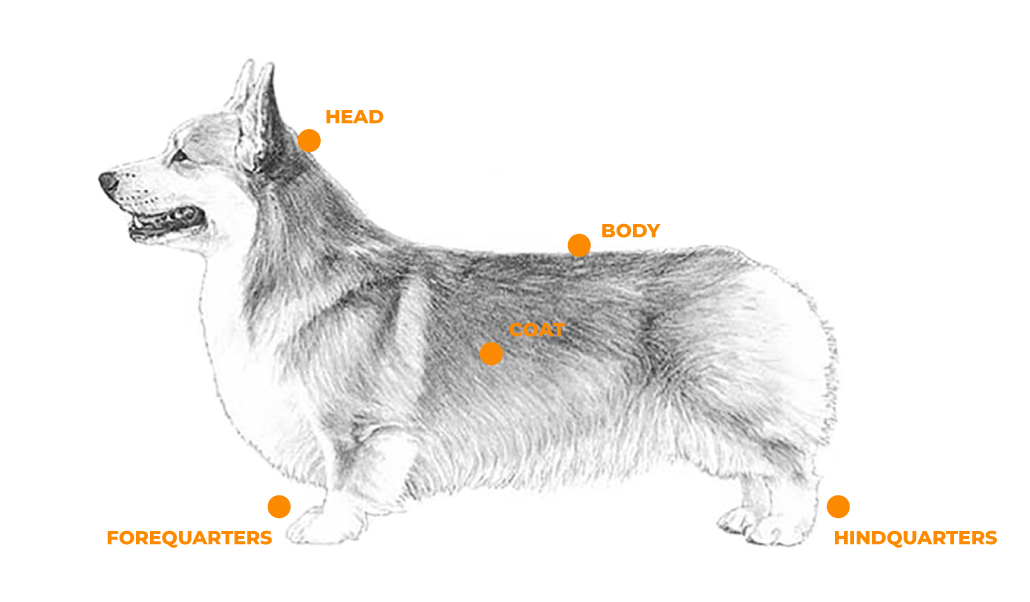A breed standard is the guideline which describes the ideal characteristics, temperament, and appearance of a breed and ensures that the breed is fit for function with soundness essential. Breeders and judges should at all times be mindful of features which could be detrimental in any way to the health, welfare or soundness of this breed.
 HEAD
HEAD
The head should be foxy in shape and appearance. Expression – Intelligent and interested, but not sly. Skull – should be fairly wide and flat between the ears. Moderate amount of stop. Very slight rounding of cheek, not filled in below the eyes, as fore face should be nicely chiseled to give a somewhat tapered muzzle. Distance from occiput to center of stop to be greater than the distance from stop to nose tip, the proportion being five parts of total distance for the skull and three parts for the fore face. Muzzle should be neither dish-faced nor Roman-nosed.
BODY
Neck – Fairly long. Of sufficient length to provide over-all balance of the dog. Slightly arched, clean and blending well into the shoulders. A very short neck giving a stuffy appearance and a long, thin or ewe neck are faulty. Topline – Firm and level, neither riding up to nor falling away at the croup. A slight depression behind the shoulders caused by heavier neck coat meeting the shorter body coat is permissible. Body – Rib cage should be well sprung, slightly egg-shaped and moderately long. Deep chest, well let down between the forelegs. Exaggerated lowness interferes with the desired freedom of movement and should be penalized. Viewed from above, the body should taper slightly to end of loin. Loin short. Round or flat rib cage, lack of brisket, extreme length or cobbiness, are undesirable. Tail – Docked as short as possible without being indented. Occasionally a puppy is born with a natural dock, which if sufficiently short, is acceptable. A tail up to two inches in length is allowed, but if carried high tends to spoil the contour of the topline.
COAT
Medium length; short, thick, weather- resistant undercoat with a coarser, longer outer coat. Over-all length varies, with slightly thicker and longer ruff around the neck, chest and on the shoulders. The body coat lies flat. Hair is slightly longer on back of forelegs and underparts and somewhat fuller and longer on rear of hindquarters. The coat is preferably straight, but some waviness is permitted. This breed has a shedding coat, and seasonal lack of undercoat should not be too severely penalized, providing the hair is glossy, healthy and well groomed. A wiry, tightly marcelled coat is very faulty, as is an overly short, smooth and thin coat. Very Serious Fault – Fluffies – a coat of extreme length with exaggerated feathering on ears, chest, legs and feet, underparts and hindquarters. Trimming such a coat does not make it any more acceptable. The Corgi should be shown in its natural condition, with no trimming permitted except to tidy the feet, and, if desired, remove the whiskers.
FOREQUARTERS
Legs – Short, forearms turned slightly inward, with the distance between wrists less than between the shoulder joints, so that the front does not appear absolutely straight. Ample bone carried right down into the feet. Pasterns firm and nearly straight when viewed from the side. Weak pasterns and knuckling over are serious faults. Shoulder blades long and well laid back along the rib cage. Upper arms nearly equal in length to shoulder blades. Elbows parallel to the body, not prominent, and well set back to allow a line perpendicular to the ground to be drawn from tip of the shoulder blade through to elbow.
HINDQUARTERS
Ample bone, strong and flexible, moderately angulated at stifle and hock. Exaggerated angulation is as faulty as too little. Thighs should be well muscled. Hocks short, parallel, and when viewed from the side are perpendicular to the ground. Barrel hocks or cowhocks are most objectionable. Slipped or double-jointed hocks are very faulty. Feet – as in front.
Sources:
https://www.akc.org/dog-breeds/pembroke-welsh-corgi/
